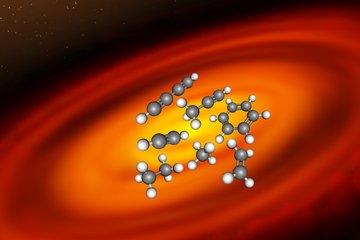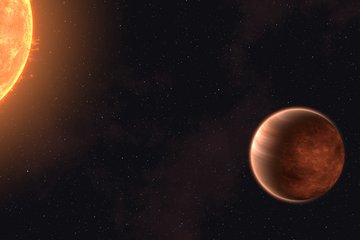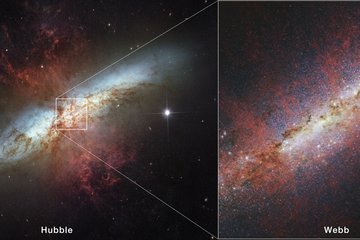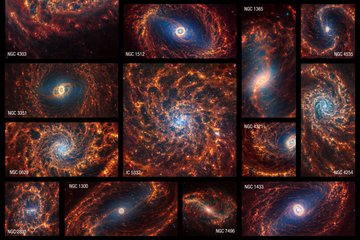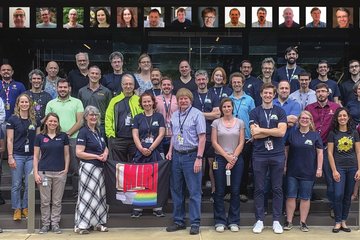Webb Telescope detects carbon dioxide in an exoplanet atmosphere
Webb ushers in a new era of exoplanet science with the first unequivocal detection of carbon dioxide in a planetary atmosphere outside our solar system.
Using the James Webb Space Telescope, an international collaboration of astronomers with MPIA's Laura Kreidberg has captured infrared light filtered through the atmosphere of a hot gas giant 700 light-years away. The transmission spectrum of exoplanet WASP-39 b represents a hat trick of firsts: Webb's first official scientific observation of an exoplanet; the first detailed exoplanet spectrum covering this range of near-infrared colours; and the first indisputable evidence for carbon dioxide in the atmosphere of a planet orbiting a distant star. The results indicate Webb's ability to spot key molecules like carbon dioxide in a wide variety of exoplanets – including smaller, cooler, rocky planets – providing insights into the composition, formation, and evolution of planets across the galaxy.

WASP-39 b is a hot, puffy gas-giant planet with a mass 0.28 times Jupiter (0.94 times Saturn) and a diameter 1.3 times greater than Jupiter, orbiting just 0.0486 astronomical units (7,270,000 km) from its star. The star, WASP-39, is fractionally smaller and less massive than the Sun. Because it is so close to its star, WASP-39 b is very hot and is likely to be tidally locked, with one side facing the star at all times.
Data collected by Webb's Near-Infrared Spectrograph (NIRSpec) show unambiguous evidence for carbon dioxide in the atmosphere. At the same time, previous observations from Hubble, Spitzer, and other telescopes indicate the presence of water vapour, sodium, and potassium. The planet probably has clouds and some form of weather but may not have atmospheric bands like those of Jupiter and Saturn.
This illustration draws from indirect transit observations from Webb as well as other space and ground-based telescopes. Webb has not captured a direct image of this planet.
The James Webb Space Telescope, operated by NASA, ESA and the CSA, has provided the first clear evidence of carbon dioxide in the atmosphere of a planet outside the solar system. This observation of a gas giant planet orbiting a Sun-like star 700 light years away provides important insights into the planet's composition and formation. The finding, which is accepted for publication in Nature, also indicates Webb's unique ability to detect and measure carbon dioxide in the thinner atmospheres of smaller rocky planets.
WASP-39 b is a hot gas-giant with a mass roughly one-quarter that of Jupiter (about the same as Saturn) and a diameter 1.3 times greater than Jupiter. Its extreme puffiness is partly related to its high temperature (about 900° Celsius or 1170 Kelvin). Unlike the cooler, more compact gas giants in our solar system, WASP-39 b orbits very close to its star – only about one-eighth the distance between the Sun and Mercury – completing one circuit in just over four Earth-days. The planet's discovery, reported in 2011, was made based on ground-based detections of the subtle, periodic dimming of light from its host star as the planet transits or passes in front of the star.
Previous observations from other telescopes, including the Hubble and Spitzer space telescopes, revealed the presence of water vapour, sodium, and potassium in the planet's atmosphere. Webb's unmatched infrared sensitivity has now confirmed the presence of carbon dioxide on this planet as well.
Filtered starlight

A transmission spectrum is made by comparing starlight filtered through a planet’s atmosphere as it moves in front of the star to the unfiltered starlight detected when the planet is beside the star. Each of the 95 data points (white circles) on this graph represents the amount of a specific wavelength of light blocked by the planet and absorbed by its atmosphere.
This spectrum is the result of measuring the change in brightness of each wavelength over time as the planet transited its star. The planet’s atmosphere absorbs some wavelengths more than others. Wavelengths absorbed by the atmosphere appear as peaks in the transmission spectrum. The hill centred around 4.3 microns represents the light absorbed by carbon dioxide (CO2).
The grey lines extending above and below each data point are error bars showing each measurement’s uncertainty or the reasonable range of actual possible values. For a single observation, the error on these measurements is extremely small.
The blue line is a best-fit model that takes into account the data, the known properties of WASP-39 b and its star (e.g., size, mass, temperature), and assumed characteristics of the atmosphere. Researchers can vary the parameters in the model – like changing unknown attributes like cloud height in the atmosphere and abundances of various gases – to get a better fit and further understand what the atmosphere is really like. This model assumes that the planet is made primarily of hydrogen and helium with small amounts of water, carbon dioxide, and a thin veil of clouds.
The team observed the planet using the NIRSpec PRISM bright object time-series mode. It employs a prism to spread out the light from a single bright object (like the star WASP-39) and measures the brightness of each wavelength at set intervals of time.
WASP-39 b is a hot gas giant exoplanet that orbits a Sun-like star roughly 700 light-years away in the constellation Virgo. The planet orbits exceptionally close to its star (less than 1/20th the distance between Earth and the Sun). It completes one orbit in just over 4 Earth-days. The planet’s discovery, based on ground-based observations, was announced in 2011. The star, WASP-39, is roughly the same size, mass, temperature, and colour as the Sun.
The background illustration of WASP-39 b and its star is based on the current understanding of the planet from Webb spectroscopy and previous ground- and space-based observations. Webb has not captured a direct image of the planet or its atmosphere.
Transiting planets like WASP-39 b, whose orbits we observe edge-on rather than from above, can provide researchers with ideal opportunities to probe planetary atmospheres. During a transit, the planet eclipses some of the starlight completely (causing the overall dimming), and some pass through the planet's atmosphere.
Because different gases absorb different combinations of colours, researchers can analyse slight differences in the brightness of the transmitted light across a spectrum of wavelengths to determine the exact composition of an atmosphere. With its inflated atmosphere and frequent transits, WASP-39 b is an ideal target for this technique called transmission spectroscopy.
First clear detection of carbon dioxide
The research team used Webb's Near-Infrared Spectrograph (NIRSpec) for its observations of WASP-39b. As a member of a European consortium, the Max Planck Institute for Astronomy (MPIA) in Heidelberg, Germany, supplied the mechanisms of the filter and grating wheels that NIRSpec uses to split the light into wavelengths. In the resulting spectrum of the exoplanet's atmosphere, the small rise in brightness between 4.1 and 4.6 microns is anything but trivial to exoplanet researchers. It is the first clear, detailed, indisputable evidence of carbon dioxide ever detected on a planet outside the Solar System.
"As soon as the data appeared on my screen, the whopping carbon dioxide feature grabbed me," said Zafar Rustamkulov, a graduate student at Johns Hopkins University in Baltimore, USA and a member of the transiting exoplanet team which undertook this investigation. "It was a special moment, crossing an important threshold in exoplanet sciences."
No observatory has ever measured such subtle differences in brightness of so many individual colours across the 3 to 5.5-micron range in an exoplanet transmission spectrum before. Access to this part of the spectrum is crucial for measuring the abundances of gases like water and methane, as well as carbon dioxide, which astronomers suspect exist in many different types of exoplanets.

This observation was made using the NIRSpec PRISM bright object time-series mode, which involves using a prism to spread out light from a single bright object (like the star WASP-39) and measure the brightness of each wavelength at set intervals of time.
To capture these data, Webb stared at the WASP-39 star system for more than 8 hours, beginning about 3 hours before the transit and ending about 2 hours after the transit was complete. The transit itself lasted about 3 hours. Each curve includes 500 individual brightness measurements – about one per minute.
Although all colours are blocked to some extent by the planet, some are attenuated more than others. The reason is that different atmospheric gases absorb different amounts of different wavelengths. As a result, each colour has a slightly different light curve. During the transit of WASP-39 b, light with a wavelength of 4.3 microns is not as bright as 3.0-micron or 4.7-micron light because carbon dioxide absorbs it.
"Detecting such a clear signal of carbon dioxide on WASP-39 b bodes well for the detection of atmospheres on smaller, terrestrial-sized planets," said Natalie Batalha of the University of California at Santa Cruz, USA, who leads the team.
Understanding the composition of a planet's atmosphere is important because it tells us something about the origin of the planet and how it evolved. Carbon dioxide molecules are sensitive tracers of the story of planet formation. Scientists can determine how much solid versus gaseous material entered this gas giant planet during its formation.
"This unequivocal detection of CO2 is a major milestone for exoplanet atmosphere characterisation," explains MPIA Director and co-author Laura Kreidberg. "CO2 is an important tracer of planet formation history: it helps us measure the complete carbon and oxygen inventory of the atmosphere, which is highly sensitive to the conditions in the disk where the planet formed.“ For example, scientists can use this CO2 measurement to better constrain the planet's original formation location, the properties of the accreted solids and gas, and the subsequent migration history of the planet.
Early Release Science
The NIRSpec observation of WASP-39 b is just one part of a more extensive investigation. It includes observing the planet using multiple instruments and measuring two other transiting planets. The investigation, which is part of the Early Release Science (ERS) program, was designed to provide the exoplanet research community with robust Webb data as soon as possible.
"The goal is to analyse the Early Release Science observations quickly and develop open-source tools for the science community to use," explained Vivien Parmentier from Oxford University, UK. "This enables contributions from all over the world and ensures that the best possible science will come out of the coming decades of observations."
"It is a joy to see a definitive detection of carbon dioxide in a hot Jupiter from the Early Release Science Program for JWST. The telescope promised to be spectacular from the beginning, and it has delivered," MPIA Director Laura Kreidberg remarked. "The exoplanet community has been searching for the signature of carbon dioxide for decades. With the extraordinary new capability of JWST, it will be possible to routinely detect carbon dioxide for hot Jupiters, as well as smaller, cooler planets more like our own Earth. I'm proud of the Transiting Exoplanet Community Early Release Science Team — hundreds of astronomers who have been working together for over five years to squeeze the most exciting science out of JWST right from the outset," Kreidberg concluded.
Additional information
The team consists of 131 astronomers from 81 research institutions. From the MPIA, the team includes: Laura Kreidberg, Thomas Henning, Luigi Mancini, Thomas Mikal-Evans, Karan Molaverdikhani, Maria E. Steinrück and Sebastian Zieba.
This press release is adapted from the original by the Space Telescope Science Institute (STScI).
MN







